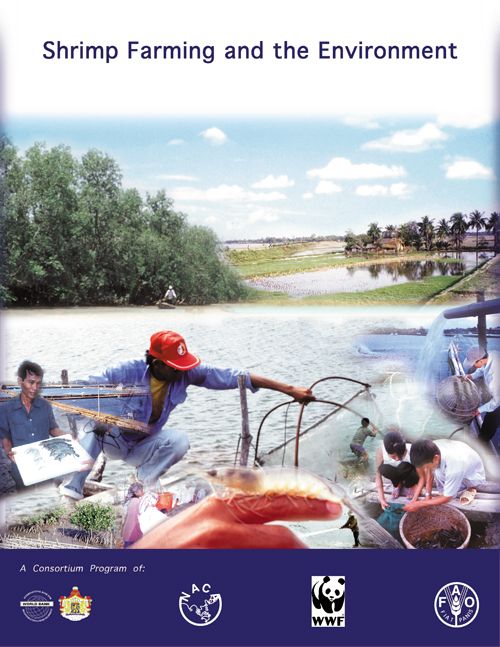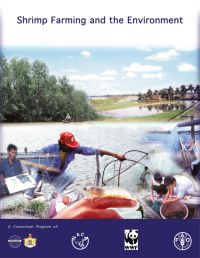Coastal shrimp aquaculture: Searching for better management practices (abstract)
23 November 2003 | Tran Van Nhuong, Michael J. Phillips and Raymon Van Anrooy | 870 Downloads | .pdf | 102.66 KB | Better management practices, Livelihoods, gender and social issues, Shrimp, Environment and Sustainability, Vietnam
This case study on coastal aquaculture management was carried out in the North and North Central of Vietnam. The study was based on primary and secondary data collected through participatory discussions and structured interviews aqua-farmers, agriculture farmers, extension officers, commune key persons, and local, provincial and national level officials.
The objectives of the study were to describe the current coastal aquaculture practises, the impact on the livelihood of the coastal inhabitants (aqua-farmers and non-aqua-farmers) and on the environment, to discuss the current situation in relation to the respective articles in the Code of Conduct for Responsible Fisheries (CCRF), and identify issues where BMPs should be introduced.
Coastal aquaculture activity in Bang La, Quang Thuan and Quynh Bang (the North and North Central of Vietnam) showed an increase after 1990 under the influence of the Doi Moi economic reform in Vietnam but is currently still characterised by extensive and improved extensive culture systems of small-scale farmers with low input use and leading to low productivity levels, but the transition to semi-extensive culture suystems is beginning. The cultured species are mainly tiger shrimp and mud crab. Aqua-farmers are showing a tendency to specialise into tiger shrimp monoculture, which offers higher net benefits but is very prone to diseases and therefore implies higher risks. The current production systems include two annual crops (shrimp/shrimp, crab/crab or shrimp/crab), average stocking densities of 2.3/m2 for shrimp and 0.9/m2 for crab in ponds of 0.8 ha and a depth of 0.8 m. Inputs provided are mainly limited to lime, livestock manure, fertiliser, pelleted feed, trash fish and molluscs, of which only lime is supplied in appropriate quantities in one commune.
Negative environmental impact of the coastal aquaculture development in the 3 communes is low because the expansion of aquaculture did not result in the destruction of large areas of mangroves (instead marshland, swamps and salt fields were converted into ponds) and the present mode of production (improved extensive) has limited effluent impact. The only sign of negative environmental impacts are observed in crab of which the prices of crab seeds are rising indicating a local overexploitation of the species.
Coastal aquaculture activities in the 3 investigated communes is currently changing rapidly from (improved) extensive to semi-intensive. Rapidly increasing population in the coastal areas is a major incentive in this process. To generate more employment and income coastal aquaculture needs to change to smaller ponds per household and higher uses of inputs leading to a higher productivity per hectare, and hopefully higher net benefits per hectare. Productivity of small ponds (around 0.2 ha) apeared to be tenfold higher than of large ponds (>1 ha). However, this study showed that pond sizes of 0.2 ha are probably too small for a household to make a living only from coastal aquaculture, considering the economies of scale related to labour inputs, stocking densities, costs and benefits of the currently used system. Further investigations into the current and more intensive production systems (pond size, stocking density, input use, marketing, etc.) are therefore needed to support the coastal aquaculture development planning processes and policies.
Though the Vietnamese Government established a strong institutional systems in theory to support aquaculture development, current institutions in the fields of aquaculture as well as fisheries are weak. This weakness in institutions governing aquaculture is recognised in terms of laws and regulation enforcement, and disharmony in supporting policies. The Sustainable Aquaculture for Poverty Alleviation (SAPA) strategy, the national aquaculture development plan for the next 10 years and the elaboration of the new Fisheries Law are therefore important initiatives and steps taken by the Ministry of Fisheries. Present major weaknesses in the system are the lack of financial and human resources (especially professional skills) and the planning of aquaculture development, what is currently slow and presents sometimes externalities like the negative impact on the environment.
Coastal aquaculture development benefitted many farming households. In addition it supported also directly the livelihoods of many often poor people that are involved in seed collection, trash fish commercialisation, feed production, processing and small scale marketing, via new employment opportunities and incomes. For each 3 aqua-farming households one household is active in services provision (seed collection, processing, marketing) in the sector. Incomes in these aquaculture services sub-sector are often better paid than in the production itself, e.g. incomes from seed supply and in the marketing of the product were on average respectively 30% and 100% higher than from aquaculture. Another advantage of coastal aquaculture is more indirectly for the local economy, due to the increased expenditures of aqua-farming households, the alternatives it offered to fisherfolk to become employed in aquaculture, and the migration (knowledge drain) to the urban centres.
The accessibility of coastal aquaculture production itself for the poorest of the poor is restricted by the decreasing availability of suitable land, the structure of the land markets, lack of technical know-how, lack of investment resources, regulations in favour of those with assets, prejudice of officials towards the capacities of the poor and the competitors in other layers in society. Especially the current land distribution practices uder the Land Law increase inequality and limit the access of the poor to aquaculture. Land use contracts in many cases are given only for 5 years and the price of the land rent increases every time when renewal is needed, in this way decreasing the opportunities for the poor to get involved and discouraging sustainable investments in aquaculture. Some government and local level policies are slowly trying to change this situation, but a positive pro-poor policy implementation is lacking. Moreover, in the 3 communes there were some efforts made by local people such as the introduction of group management strategies, in which poor farmers together manage and reap the benefits of a common property pond. Initiatives of this kind show that the poor can benefit a lot from aquaculture, but support and training in pondmanagment, planning and incentives to invest are definitely needed to get more poor actively involved in aquaculture development.
With respect to the articles of the Code of Conduct for Responsible Fisheries (CCRF) and the current situation in coastal aquaculture in the 3 communes it can be concluded that:
- Article 9.1.1 of the CCRF which stresses the importance of a legal and administrative framework present is considered very important by both the aqua-farmers as the Ministry of Fisheries in Vietnam. The new Land Law (1999) and the current preparatory work on the Fisheries Law are major steps forward, taking in consideration the positive impact of these new regulations will have on investments, environment, management and last but not least the land use rights in the sector. Aquaculture land use rights/contracts have, within these new laws, a similar status as forestry land (20 years contracts) and this offers a base for more investments in and consequently more intensification of the aquaculture sector.
- Article 9.1.2, that discusses the effects of aquaculture development on genetic diversity and ecosystem integrity, is not considered a direct priority by the aqua-farmers because the introduction of non-native species has been limited to tilapia culture in coastal aquaculture and no negative environmental and production effects were observed so far.
- Article 9.1.3, which point out the need for updating of aquaculture development plans and strategies, is satisfied at government and provincial level with the production of 5 and 10 years plans, but that enforcement of the aquaculture related plans and regulations is the weak point. Aquafarmers in this study mentioned the lack of sufficient good skilled extension workers to guarantee the dissemination of knowledge of BMPs, necessary for sustainable coastal aquaculture development, to them.
- Article 9.1.4, that aims at ensuring that no negative impact on other sectors will arise from aquaculture development, is seen as important by the aqua-farmers with reference to the avoidance of (future) conflicts. In the study area, fisherfolk and aqua-farmers now have mutual benefits from each others activities, because fisherfolk supplies trash fish and seeds to the aquaculture farmers. Future possible negative effects can be minimised by introduction of participatory development approaches at local level.
- Article 9.1.5, which stresses the need for environmental impact assessment (EIA), is not well developed yet. EIA activities are still in a pilot phase, but aquafarmers are likely to support efforts in this field.
- Article 9.4.1, that discusses the importance of responsible aquaculture practices for rural communities, organisations and aqua-farmers, is considered as of major importance by the aqua-farmers. At national level a small-scale aqua-farmer producer organisation does not exist yet in Vietnam. However, in one of the case study communes the aqua-farmers organised them selves in a cooperative type of group in order to improve the management of common property water resources. In general, community institutions are not well developed in the aquaculture field, and there is a common lack of understanding of the importance of those institutions for the long-term sustainable coastal aquaculture development.
- Article 9.4.2, that states that active participation of the stakeholders in the aquaculture development should be promoted, is considered very important by the aqua-framers. Top-down approaches are still commonly used and the participation of the local community in the local development planning is limited. Participative methods are not well known neither practised so far by local planners and extension workers.
- Articles 9.4.3, 9.4.4 and 9.45, that discuss the use of appropriate feeds, fertilisers, the health
- management practices and the regulation of chemical inputs, are not yet very applicable in the current coastal aquaculture activities in the case study areas. Input levels used are still low, what indicates that few fertiliser, chemical inputs, drugs and antibiotics are used. Most inputs are locally produced and are directly derived from natural resources, a characteristic that should be built further on in the implementation of BMPs. The incidence of diseases in the currently used (improved) extensive mud crab and shrimp is high. Economic losses are still relatively small, but are likely to rise with increasing stocking densities and without proper management practices. Aqua-farmers are very willing to learn about disease preventive measures and other pond management related BMPs, but aquaculture extension in these fields is only limited available.
- Article 9.4.6, which points out the importance of responsible aquaculture related waste management, is regarded as a major issue by the aqua-farmers. Waste disposal is considered as a real problem by the aqua-farmers but alternatives for the present conduct (of burying and/or burning) are not available. BMPs development in this respect are highly needed.
- Article 9.4.7, that stresses the food safety and product quality of aquaculture products, is considered by the aqua-farmers as of relatively less importance, because almost all activities under this article are carried out by middlemen and processors. A marketing channel approach is not very well developed yet in this respect.
- The case studies show that an increase in quantity and quality of aquaculture research and extension to develop further and implement, both in a participatory way, new BMPs in pond management, more intensive production systems, disease prevention measures and product quality management, appear necessary. In addition, the contribution of aquaculture development to the reduction of poverty in coastal areas in Vietnam is definitely significant and visible and the challenge of formulation and implementation of pro-poor policies in the sector, including pro-poor extension services, is taken up by the government and aqua-farmers together. In this respect, advantage should be taken of the present willingness of aquafarmers to improve their management practices in the process of transformation from (improved) extensive to semi-intensive farming systems.
Copyright, all rights reserved.

